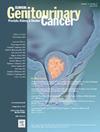The Utility of Contemporary Community-Based Prostate Cancer Screening Campaigns
IF 2.7
3区 医学
Q3 ONCOLOGY
引用次数: 0
Abstract
Introduction
While early detection of prostate cancer (PCa) might provide benefits in terms of PCa mortality, this might be associated with overdiagnosis and overtreatment of indolent cancers. We aimed to evaluate our community-based PCa early-detection campaigns.
Methods
A retrospective review of 19 PCa early-detection campaigns led by our institution was conducted between 2015 and 2023. These campaigns included PSA testing and digital rectal examinations (DRE) for all comers, followed by elective workup of at-risk patients, with follow-up PSA testing and multiparametric MRI (mpMRI). Data were reviewed for demographics and clinical parameters. Descriptive statistics were used to describe the data. Logistic regression was used to identify the factors associated with diagnosis of PCa.
Results
1171 men were included with median PSA of 1.1 ng/ml (IQR 0.6-2.5). Eighty seven men (7.4%) underwent prostate biopsy. Of those, 66 (76%) were diagnosed with prostate cancer (14% with Gleason grade group (GG) 1 and 86% with GG2 or higher—clinically significant prostate cancer (csPCa). Higher PSA (OR 1.62, 95% CI 1.42-1.85, P < .0001) and suspicious DRE (OR 97, 95% CI 38-248, P < .0001) were associated with diagnosis of csPCa. The number needed to screen to diagnose 1 case of PCa was 18 (95% CI 14-22) and the number needed to screen to diagnose 1 case of csPCa was 21 (95% CI 16-27).
Conclusion
Herein we describe our experience with contemporary PCa screening campaigns combining traditional screening with PSA and DRE with prostate MRI and judicious use of prostate biopsy.
当代社区前列腺癌筛查活动的效用。
虽然前列腺癌(PCa)的早期检测可能对降低前列腺癌的死亡率有好处,但这可能与惰性癌症的过度诊断和过度治疗有关。我们的目的是评估我们基于社区的前列腺癌早期检测活动。方法:回顾性分析我院2015 - 2023年开展的19项前列腺癌早期检测活动。这些活动包括对所有患者进行PSA检测和直肠指检(DRE),随后对高危患者进行选择性检查,随访PSA检测和多参数MRI (mpMRI)。对数据进行了人口统计学和临床参数的审查。采用描述性统计对数据进行描述。采用Logistic回归来确定与PCa诊断相关的因素。结果:1171名男性纳入研究,中位PSA为1.1 ng/ml (IQR 0.6-2.5)。87例(7.4%)行前列腺活检。其中66例(76%)被诊断为前列腺癌(14%为Gleason分级组(GG) 1, 86%为GG2或更高临床意义的前列腺癌(csPCa))。较高的PSA (OR 1.62, 95% CI 1.42-1.85, P < 0.0001)和可疑的DRE (OR 97, 95% CI 38-248, P < 0.0001)与csPCa的诊断相关。诊断1例PCa需要筛查的人数为18人(95% CI 14-22),诊断1例csPCa需要筛查的人数为21人(95% CI 16-27)。结论:在此,我们描述了我们当代前列腺癌筛查活动的经验,结合传统筛查与PSA和DRE与前列腺MRI和明智地使用前列腺活检。
本文章由计算机程序翻译,如有差异,请以英文原文为准。
求助全文
约1分钟内获得全文
求助全文
来源期刊

Clinical genitourinary cancer
医学-泌尿学与肾脏学
CiteScore
5.20
自引率
6.20%
发文量
201
审稿时长
54 days
期刊介绍:
Clinical Genitourinary Cancer is a peer-reviewed journal that publishes original articles describing various aspects of clinical and translational research in genitourinary cancers. Clinical Genitourinary Cancer is devoted to articles on detection, diagnosis, prevention, and treatment of genitourinary cancers. The main emphasis is on recent scientific developments in all areas related to genitourinary malignancies. Specific areas of interest include clinical research and mechanistic approaches; drug sensitivity and resistance; gene and antisense therapy; pathology, markers, and prognostic indicators; chemoprevention strategies; multimodality therapy; and integration of various approaches.
 求助内容:
求助内容: 应助结果提醒方式:
应助结果提醒方式:


